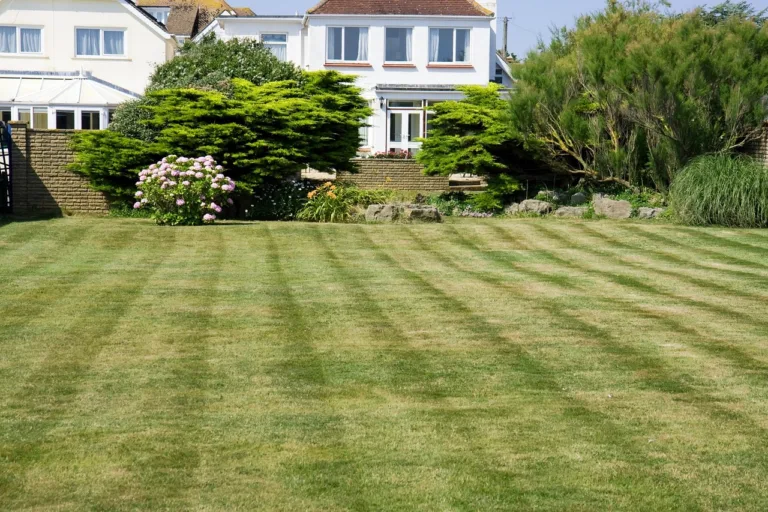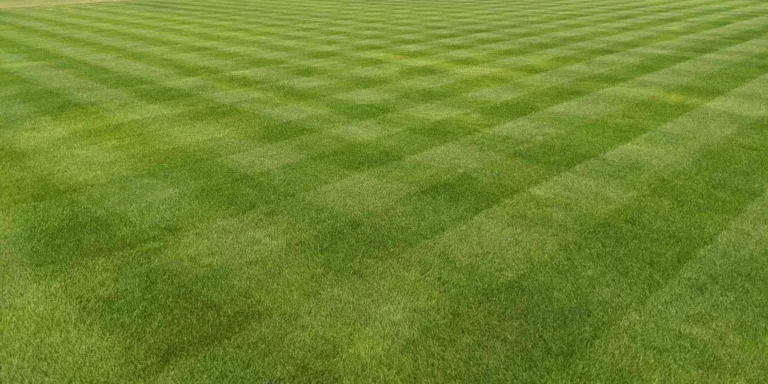What’s the secret to a striped lawn? How can you mow grass stripes into your garden, and what are the best tips for distinctive light and dark lines?
I’ve shared the step-by-step process to mowing lawn stripes below.
 How Do You Mow Stripes In Your Lawn?
How Do You Mow Stripes In Your Lawn?
To mow stripes in your lawn, you just need a lawn mower with a roller. Mow back and forth in straight lines, mowing in the opposite direction with each lap.
The light and dark stripes are produced when light reflects off the grass blades that have been bent in opposite directions. The blades bent towards you should look darker, while the blades bent the opposite way should look lighter.
Table of Contents
❓ How To Mow Lawn Stripes: Step-By-Step
Follow these simple steps for creating stripes in your lawn:
Step 1: Prepare Your Mower
To mow lawn stripes, you need a mower with a rear roller attachment. This roller pushes the grass blades in the cutting direction as you mow, making stripes in your lawn.
The heavier and better-built the roller, the more the stripes stand out.
If you have a cylinder mower, it probably comes with a built-in rear roller. There are electric and manual cylinder mowers that offer a high-quality cut and give that sought-after striped lawn appearance.
A rotary mower, on the other hand, is unlikely to come with an roller, but you can buy a striping kit (which comes with the weighted bar that you need to create those beautiful stripes to attach to your mower rather than having to buy a whole new mower.
Step 2: Mow The Lawn Perimeter
Once you’ve established that you have the right kind of mower for stripes, you can start mowing.
Begin by mowing two widths of the border of your lawn (or your lawn’s perimeter), which will frame your stripes nicely and give you plenty of turning room after each lap.
- Brand: Hyundai
Price: ££
Power source: Electric corded
Cutting width: 38cm
Cut height range: 20-70mm
Weight: 13.79 kilograms
Grass box capacity: 40 litres
Dimensions (DxWxH): 42 x 37 x 107cm
Power: 1600 W
Step 3: Choose Your Mowing Direction
After mowing your lawn perimeter, choose the direction of your stripes.
Most people prefer vertical stripes that run at right angles to their home when viewing their lawn from the back door. However, the direction of striping is your choice – there’s no right or wrong here!

Step 4: Mow Your First Stripe
Now you’re ready to mow your first stripe. Starting at one corner, mow the first straight line of your lawn.
Since you’ve already mowed your lawn perimeter, you can use this border for reference to make sure you’re mowing straight.
Step 5: Mow The Rest Of The Stripes
Once you reach the opposite side of your garden, turn and mow the second stripe by walking in the opposite direction to your previous stripe.
The roller will push the grass in the opposite direction, and the light reflecting off this stripe will give it a lighter or darker colour (depending on where you’re standing and where the sun is in the sky).
Continue mowing back-and-forth until you’ve covered your entire lawn.
Want to know which mowers I recommend for lawn stripes? Check out my guide to the best lawn mowers for a striped lawn.

🧐 Our Top Tips For Mowing Lawn Stripes
To finish, here’s a roundup of our top recommended tops for achieving a stripy lawn at home:
A stripy lawn isn’t necessarily a healthy lawn, so don’t neglect other aspects of lawn maintenance, including deweeding and de-thatching, over-seeding when necessary, and feeding your lawn with a fertilizer.
You can “train” your lawn to stay stripy for longer by mowing the same stripes in the same direction, but it’s still best to switch up your direction occasionally to give your grass the most nourishment from the sun.
Overlap each line with the previous line to accentuate the definition of your stripes.
If you can, lift your mower deck as you turn at the end of each lap, which will prevent the roller from leaving lines at your turning points.
You can get the best finish by double cutting – doing a few passes over your lawn to give better definition.
❓ FAQ
What’s the best way to mow stripes on a curved lawn?
If your lawn is curved and you can’t mow perpendicular to a straight edge, I recommend fixing your gaze on a spot directly in front of you at the end of the lawn as you mow. This should help you to mow straight lines even if you have curved edging around your garden.
What height do you mow stripes?
The ideal height for visible lawn stripes is 2-3cm. Any shorter than this and the stripes won’t be as distinctive, and if your grass is too long, it look messy. It’s better to have longer grass for mowing stripes, though, because it makes it easier to achieved well-defined light and dark lines.
Is lawn striping good for the lawn?
Lawn striping can be good for your lawn if you mow in different directions each time. So, if you started at one end of your garden in your last lawn mowing session, start mowing at the other end, in the opposite direction, the next session. Bending your grass at different angles with each cut allows all portions of your lawn to be nourished by the sun.
Which way do you mow stripes?
You can mow stripes in any direction on your lawn, whether you prefer horizontal, vertical, or diagonal (when viewed from your house). The only rule is to mow in opposite directions with each lap, which is what gives your lawn the striped appearance.


